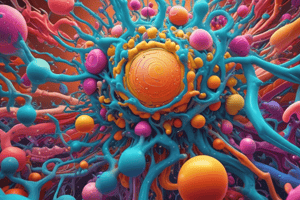Podcast
Questions and Answers
What percentage of proteins in the plasma membrane are integral/intrinsic proteins?
What percentage of proteins in the plasma membrane are integral/intrinsic proteins?
- 90% (correct)
- 30%
- 50%
- 70%
What type of transport requires energy and moves substances against the concentration gradient?
What type of transport requires energy and moves substances against the concentration gradient?
- Passive diffusion
- Osmosis
- Active transport (correct)
- Facilitated diffusion
Which type of protein movement was confirmed by the 1972 Singer & Nicolson model for the plasma membrane?
Which type of protein movement was confirmed by the 1972 Singer & Nicolson model for the plasma membrane?
- Flip-flop movement
- Lateral movement (correct)
- Rotational movement
- None of the above
What is the main example of a channel protein involved in facilitated diffusion?
What is the main example of a channel protein involved in facilitated diffusion?
What is the role of glycoproteins on the cell surface?
What is the role of glycoproteins on the cell surface?
Study Notes
Protein Classification
- Peripheral proteins make up 10% of membrane proteins, while integral proteins make up 90%
- Integral proteins are transmembrane or in-wall, meaning they span across the membrane or are embedded in it
Transport Mechanisms
Passive Transport
- Occurs along the concentration gradient, requiring no energy
- Examples include passive diffusion, where molecules move from an area of higher concentration to an area of lower concentration
Facilitated Diffusion
- Involves the use of channel proteins or carrier proteins to facilitate transport
- Channel proteins form a pore or channel in the membrane, allowing specific molecules to pass through
- Examples include porin proteins
Active Transport
- Transport occurs against the concentration gradient, requiring energy consumption
- Examples include the Na+ pump, which transports sodium ions into the cell against their concentration gradient
Osmosis
- Movement of water molecules from an area of higher concentration to an area of lower concentration
- Occurs through a selectively permeable membrane, allowing polar molecules like water to pass through
Plasma Membrane
- Discovered by Singer and Nicolson in 1972
- Labeling proteins on the membrane surface confirms the fluid mosaic model, where proteins are able to move laterally but do not flip-flop across the membrane
Glycoproteins and Cell Recognition
- Glycoproteins, or sugar-proteins, are important for cell-to-cell recognition
- They provide mobility and flexibility to the cell surface, allowing for interactions with other cells
Studying That Suits You
Use AI to generate personalized quizzes and flashcards to suit your learning preferences.
Description
This quiz covers the types of proteins and their roles in cell membrane transport, including peripheral and integral proteins, passive and active transport, facilitated diffusion, and osmosis.




